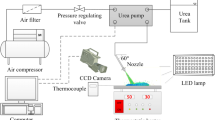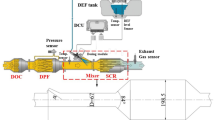Abstract
Urea aqueous solution is injected into the hot exhaust flow which acts as the source of ammonia in SCR systems to reduce the NOx emissions of diesel vehicles. However, urea decomposition thus ammonia generation is not always perfect, resulting in solid urea deposit formation accumulated in exhaust pipe wall, on the catalyst surface and mixing element. Decomposition of urea and mitigation of solid deposit formation is a great challenge to implement automotive SCR systems. This study presents a combined experimental and numerical investigation of UWS spray, droplet breakup, urea decomposition and deposit formation of SCR systems. The investigation firstly focused on fundamental spray characteristics of UWS and its effects on urea decomposition. The experiment was conducted with a commercial pressure driven SCR injector into an optically accessible test chamber and z-type shadowgraph imaging was implemented to capture the spray images. Relevant dimensions of spray images were estimated by digital image processing. The injection quantity of the experimental injector was measured to get the injection rate. Temperature distribution in the exhaust pipe and ammonia mass fraction was measured for different exhaust gas temperatures to estimate the urea decomposition. Finally, FTIR was used to analyze the chemical composition of solid deposit formed due to incomplete urea decomposition. The numerical assessment was carried out by using STAR CCM+ CFD code. The Eulerian-Lagrangian approach was implemented for the modeling of multiphase flow and urea water spray droplets. The investigation reveals that higher injection pressure increases the risk of wall impingement and wall wetting that leads to deposit formation. Though injection pressure is dominant on droplet size, exhaust gas temperature has also significant effects on droplet size and evaporation. Spray injection causes local cooling that effects on urea decomposition and relatively higher exhaust gas temperature is required for the complete decomposition of urea. Major chemical composition identified in the deposit sample are unreacted urea, biuret, and cyanuric acid.
Similar content being viewed by others
References
H. Lee, T. Ha and H. Choi, Experimental verification of optimized NOX reduction strategies in a decrepit Euro-3 diesel engine retrofitted with a cooled EGR system, Journal of Mechanical Science and Technology, 30 (6) (2016) 2873–2880.
A. Datta and B. K. Mandal, Numerical investigation of the performance and emission parameters of a diesel engine fuelled with diesel-biodiesel-methanol blends, Journal of Mechanical Science and Technology, 30 (4) (2016) 1923–1929.
S. Grout et al., Experimental investigation on the injection of an urea-water solution in hot air stream for the SCR application: Evaporation and spray/wall interaction, Fuel, 106 (2013) 166–177.
T. Johnson, Vehicular emissions in review, SAE International Journal of Engines, 6 (2) (2013) 699–715.
S. M. Cho, Properly apply selective catalytic reduction for NOx removal, Chemical Engineering Progress, 90 (1) (1994) 39–45.
Optimization of ammonia source for SCR applications, Proceedings of the 2003 Mega Symposium (2003).
A. Fritz and V. Pitchon, The current state of research on automotive lean NOx catalysis, Applied Catalysis B: Environmental, 13 (1) (1997) 1–25.
S. D. Yim et al., Decomposition of urea into NH3 for the SCR process, Industrial & Engineering Chemistry Research, 43 (16) (2004) 4856–4863.
H. Dong, S. Shuai and J. Wang, Effect of urea thermal decomposition on diesel NOx-SCR aftertreatment systems, SAE Technical Paper (2008).
G. Zheng et al., Investigation of urea deposits in urea SCR systems for medium and heavy duty trucks, SAE Technical Paper (2010).
A. Lundstrom and C. Tekniska Hogskola, Urea decomposition for urea-SCR applications: Experimental and computational fluid dynamics studies, Chalmers University of Technology, Goteborg (2010).
P. Way et al., SCR performance optimization through advancements in aftertreatment packaging, SAE Technical Paper (2009).
V. O. Strots et al., Deposit formation in urea-SCR systems, SAE International Journal of Fuels and Lubricants, 2 (2009-01-2780) (2009) 283–289.
L. Xu et al., Laboratory and engine study of urea-related deposits in diesel urea-SCR after-treatment systems, SAE Technical Paper (2007).
F. Birkhold, Selektive katalytische reduktion von stickoxiden in kraftfahrzeugen: Untersuchung der einspritzung von harnstoffwasserlösung, Shaker (2007).
E. Abu-Ramadan, K. Saha and X. Li, Numerical modeling of the impingement process of urea-water solution spray on the heated walls of SCR systems, SAE Technical Paper (2012).
P. D. Gaynor et al., An experimental investigation into DEF dosing strategies for heavy duty vehicle applications, SAE 2015 World Congress & Exhibition (2015).
J. Baleta et al., Numerical analysis of ammonia homogenization for selective catalytic reduction application, Journal of Environmental Management, 203 (2017) 1047–1061.
P. M. Schaber et al., Thermal decomposition (pyrolysis) of urea in an open reaction vessel, Thermochimica Acta, 424 (1–2) (2004) 131–142.
C. L. Weeks et al., Analytical investigation of urea deposits in SCR system, SAE International Journal of Engines, 8 (2015-01-1037) (2015) 1219–1239.
S. Fischer et al., Impact of the turbulence model and numerical approach on the prediction of the ammonia homogenization in an automotive SCR system, SAE International Journal of Engines, 5 (2012-01-1291) (2012) 1443–1458.
H. J. Dan and J. S. Lee, Modeling and measurement of boiling point elevation during water vaporization from aqueous urea for SCR applications, Journal of Mechanical Science and Technology, 30 (3) (2016) 1443–1448.
H. Smith et al., Optical and numerical investigations on the mechanisms of deposit formation in SCR systems, SAE International Journal of Fuels and Lubricants, 7 (2014-01-1563) (2014) 525–542.
C. Bai and A. D. Gosman, Development of methodology for spray impingement simulation, SAE Technical Paper (1995).
P. K. Senecal et al., An investigation of grid convergence for spray simulations using an LES turbulence model, SAE Technical Paper (2013).
C. T. Crowe et al., Multiphase flows with droplets and particles, CRC Press (2011).
S. Drennan et al., Application of automatic meshing to urea-water injection simulation for engine aftertreatment, SAE Technical Paper (2015).
Author information
Authors and Affiliations
Corresponding author
Additional information
Recommended by Associate Editor Jeong Park
Ock Taeck Lim received his B.S. and M.S. degrees in Mechanical Engineering from Chonnam National University, Korea, in 1998 and 2002, respectively. He received his Ph.D. degree from Keio University in 2006. Dr. Lim is currently a Professor at the School of Mechanical & Automotive Engineering at Ulsan University, Korea. Dr. Lim’s research interests include Internal Combustion Engines, Alternative Fuels and Emission reduction.
G. M. Hasan Shahariar received his B.Sc. in Mechanical Engineering from Khulna University of Engineering & Technology (KUET), Bangladesh in 2014. Currently, he is doing his M.Sc. under the supervision of Professor Dr. Ock Taeck Lim. His research interest includes Emission reduction, Spray analysis, Spray simulations.
Rights and permissions
About this article
Cite this article
Shahariar, G.M.H., Lim, O.T. Investigation of urea aqueous solution injection, droplet breakup and urea decomposition of selective catalytic reduction systems. J Mech Sci Technol 32, 3473–3481 (2018). https://doi.org/10.1007/s12206-018-0651-5
Received:
Revised:
Accepted:
Published:
Issue Date:
DOI: https://doi.org/10.1007/s12206-018-0651-5




